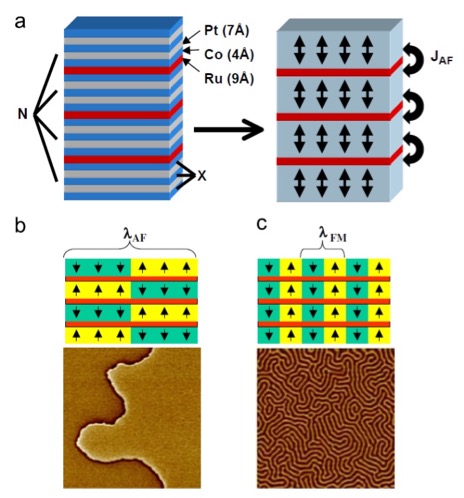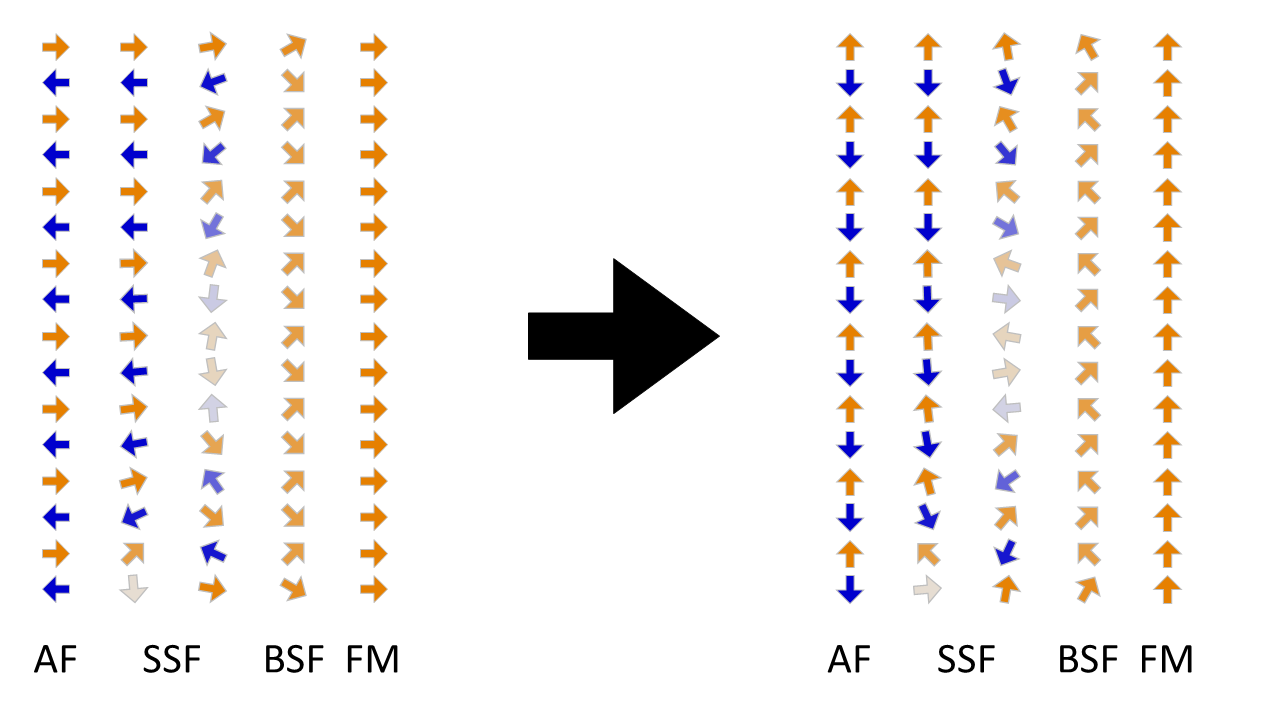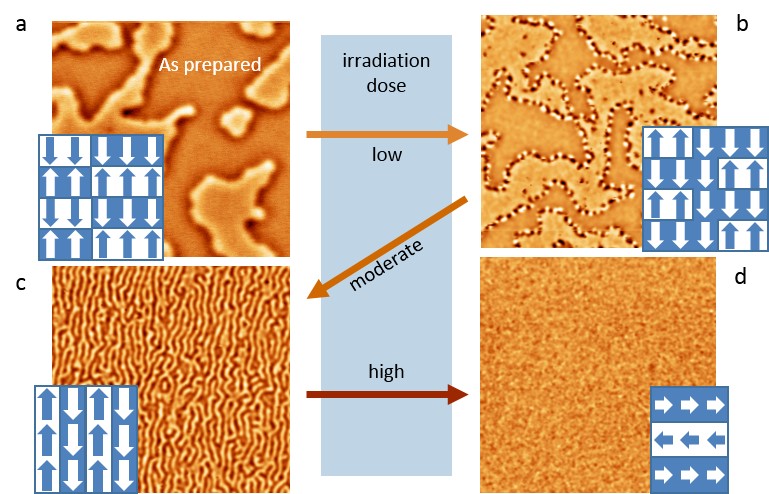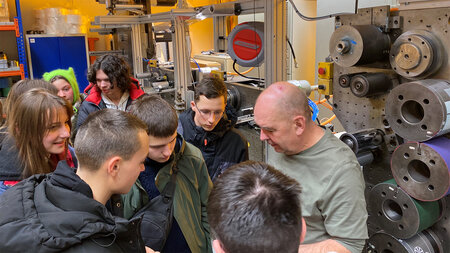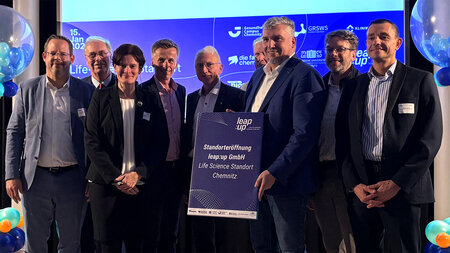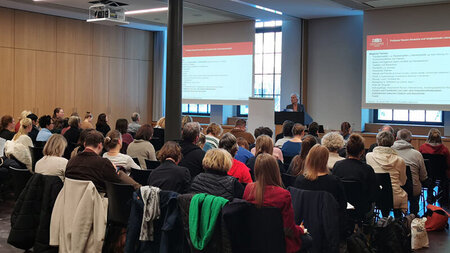Synthetic Antiferromagnets with Perpendicular Magnetic Anisotropy
Magnetic Domain Formation
Figure: (a) Schematic illustration of the ML structure for the case X = 3 and N = 4. The Co/Pt stacks can be viewed as uniform FM units with the magnetization pointing either parallel or antiparallel to the film normal. Each FM layer stack is AF-coupled to its adjacent stacks via Ru inter-layers, while dipolar fields favor a parallel alignment of the moments in adjacent stacks. (b) AF domain structure of lateral periodicity λAF. As an example we show an experimental MFM image (10 µm)2 of a N = 17, X = 6 sample after trapping domains via AC demagnetization. (c) FM stripe domain structure of lateral periodicity λFM. As an example we show an experimental MFM image (10 µm)2 of a N = 18, X = 9 sample after AC demagnetization.
As a consequence one can stabilize for example the coexistence of different remanent states [3] and the formation of new types of AF domain wall topologies that may be used for future magnetic information storage or processing. In this context we will explore reversal modes via Magnetic Force Microscopy (MFM) in an external field as well as magnetotransport properties during field reversal as well as for different remanent domain topologies.
Download the corresponding poster.
[1] O. Hellwig, T. L. Kirk, J. B. Kortright, A. Berger, and E. E. Fullerton, Nature Materials 2 (2003), 112.
[2] O. Hellwig, A. Berger and E. E. Fullerton, Phys. Rev. Lett. 91 (2003), 197203.
[3] O. Hellwig, J. B. Kortright, A. Berger and E. E. Fullerton, J. Magn. Magn. Mater. 319 (2007), 13.
Surface Spin Flop
At the surfaces, the AF exchange coupling is weaker as they are only coupled to one side. The SSF occurs, if the surface moments point opposite to the external magnetic field. If the field is high enough, at this surface, the magnetic moment is instantaneously tilted approximately by 90°. Due to the strong AF exchange, the tilting decays with increasing distance from the surface. In order to align both surface moments with the field, the tilted state is pushed into the system and gets trapped as a vertical domain wall in finite synthetic layered antiferromagnets with an even number of layers. The stability of this so called SSF state is limited to a small field range. As soon as the vertical domain wall reaches the center of the antiferromagnet, it expands and transforms for higher external fields into the bulk spin flop. Due to the dominant AF exchange, the whole process is laterally homogenous and thus can be modeled as a one-dimensional system.
Co/Pt multilayers are a well-known material system with perpendicular anisotropy [3, 4]. By introducing Ir as an interlayer, a strong AF interlayer exchange coupling can be achieved [5]. As no single crystal substrate is needed, the multilayers can be deposited on a wide variety of substrates while maintaining their magnetic properties. In this material system, we show the existence of the SSF for perpendicular anisotropy. Furthermore, we demonstrate ways to stabilize the laterally homogenous vertical domain wall state of the SSF at remanence for possible spin wave applications.
Figure: Magnetic states in exchange dominated layered antiferromagnets with in-plane magnetic anisotropy (left) and perpendicular magnetic anisotropy (right). AF – antiferromagnetic ground state, SSF – Surface Spin Flop, BSF – Bulk Spin Flop, FM – ferromagnetic saturated state.
[1] D. L. Mills, Phys. Rev. Lett. 20 (1968), 18.
[2] R. W. Wang, et al., Phys. Rev. Lett. 72 (1994), 920.
[3] P. F. Carcia, J. Appl. Phys. 63 (1988), 5066.
[4] O. Hellwig, J. B. Kortright, A. Berger and E. E. Fullerton, J. Magn. Magn. Mater. 319 (2007), 13.
[5] S. S. P. Parkin, Phys. Rev. Lett. 67 (1991), 3598.
Ion Beam Irradiation
Figure: MFM images (5 µm x 5 µm) showing the various types of domain structures observed in He-ion irradiated perpendicular AF-coupled Co/Pt/Ru multilayers after in-plane demagnetization along the horizontal axis. (a) Two-dimensional AF domains with sharp domain walls with no irradiation. (b) With a low dose of irradiation, two-dimensional AF domains with domain walls consisting of a one-dimensional FM stripe domain phase appear. (c) FM stripe domains expand throughout the entire sample with moderate doses. (d) With high irradiation dose, in-plane preferred magnetization with no domains can be observed.
We want to explore and optimize such ion irradiation processes for systems based on Co/Pt and Co/Pd perpendicular anisotropy multilayers that are antiferromagnetically coupled via Ru or Ir interlayers that naturally reveal a phase transition from large antiferromagnetic domains to relatively small ferromagnetic stripe domains as shown in the images [1-3]. The antiferromagnetic structure being fully magnetically compensated in vertical direction with no stray fields penetrating through the surface is complemented by ferromagnetic stripe domains that create large stray fields above the surface and thus are able to interact with neighboring layers via their demagnetization fields even if direct magnetic exchange is not present. Moreover, the usage of other materials like Ni and Ir for the multilayer may allow discrete manipulation of the energetic contributions. In combination with local ion irradiation, it may be possible to write ferromagnetic structures or alter the magnetic anisotropy (irradiated regions) into an antiferromagnetic background (non-irradiated region) and thus create an infrastructure for information processing in adjacent magnetic layers [4-6]. Furthermore, we want to explore the potential of such ion irradiated heterogeneous infrastructures interacting with other magnetic thin film systems via direct exchange as well as via indirect dipolar interactions.
Download the corresponding poster.
[1] O. Hellwig, T. L. Kirk, J. B. Kortright, A. Berger, and E. E. Fullerton, Nature Materials 2 (2003), 112.
[2] O. Hellwig, A. Berger and E. E. Fullerton, Phys. Rev. Lett. 91 (2003), 197203.
[3] O. Hellwig, J. B. Kortright, A. Berger and E. E. Fullerton, J. Magn. Magn. Mater. 319 (2007), 13.
[4] C. Chappert et al., Science 280 (1998), 1919.
[5] A. Mougin, T. Mewes, M. Jung, D. Engel, A. Ehresmann, H. Schmoranzer, J. Fassbender, and B. Hillebrands, Phys. Rev. B 63 (2001), 060409.
[6] A. Ehresmann, O. Hellwig, O. Buhl, N. D. Müglich, T. Weis, and D. Engel, J. Appl. Phys. 112 (2012), 063901.


